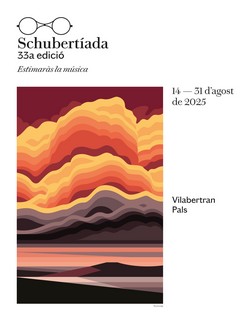
To get an idea of this piece I will add a brief and basic analysis:
- Tone: Starts in A flat minor and changes to A flat major.
- Compass: Binary 6/8
- Tempo: Mässig geschwind (moderately fast)..
- Form: Strophic Lied A-A'-A''
- Text: Poem by Friedrich Leopold zu Stolberg (1750-1819).
As for its harmony, it begins with an A flat minor that changes to A flat major, which creates harmonious ambiguity and seems to be the movement between the marine world and what floats on it.
When interpreting this lied it is greatly helpful to make a visualization of the landscape that surrounds us, being able to feel the swaying of the boat (when an octave arises and then descends) rocked by the waves of the sea (fast score) and the reddish light of the sunset that dyes all our landscape.
The importance of what we say when singing can be one of the most beautiful elements we can transmit. In this case, one can see that this work repeats the same melody three times, so what differentiates each repetition is only the text, thanks to which we can give a different nuance to each repetition.
The beauty of the words makes each note acquire a different intonation and emotion. That is why it is of vital importance to make a very detailed work of translation and transcription; the same pronunciation of the language, in many cases, will help make musical sense to the work.
The importance of what we say when singing can be one of the most beautiful elements we can transmit. In this case, one can see that this work repeats the same melody three times, so what differentiates each repetition is only the text, thanks to which we can give a different nuance to each repetition.
The beauty of the words makes each note acquire a different intonation and emotion. That is why it is of vital importance to make a very detailed work of translation and transcription; the same pronunciation of the language, in many cases, will help make musical sense to the work. As for the vocal and interpretive resources that can be used to sing this lied, it is important to indicate that the vocal register that one has is very important for a soprano, since there are fragments that are affected by the area of passage between registers. To avoid a negative effect, we must have a very defined vision of the text and the melody. The text must be pronounced on the lips so that the voice is projected more and at all times one must look for the musical direction
Mitten im Schimmer der spiegelnden Wellen
Gleitet, wie Schwäne, der wankende Kahn;
Ach, auf der Freude sanft schimmernden Wellen
Gleitet die Seele dahin wie der Kahn;
Denn von dem Himmel herab auf die Wellen
Tanzet das Abendrot rund um den Kahn.
Über den Wipfeln des westlichen Haines
Winket uns freundlich der rötliche Schein;
Unter den Zweigen des östlichen Haines
Säuselt der Kalmus im rötlichen Schein;
Freude des Himmels und Ruhe des Haines
Atmet die Seel’ im errötenden Schein.
Ach, es entschwindet mit tauigem Flügel
Mir auf den wiegenden Wellen die Zeit.
Morgen entschwinde mit schimmerndem Flügel
Wieder wie gestern und heute die Zeit,
Bis ich auf höherem strahlendem Flügel
Selber entschwinde der wechselnden Zeit.
In the midst of the shimmer of reflecting waves
Like swans, glides the bouncing rowboat
Ah, over the joyous, gently-shimmering waves
Glides the soul like the rowboat.
Ah, over the joyous, gently-shimmering waves
Glides the soul like the rowboat.
From the heaven on down the waves
Dances the evening glow around the boat
Above the top of the western grove
Friendly greets us the red glow;
Heavenly joy and the peace of the groves
The soul breathes in the evening glow,
Ah, disappears from me with the dewey wings
On rocking waves, flies the time
Disappears tomorrow on shimmering wings
Just like yesterday and today, flies the time.
Until I myself on more highly radiant wings
Flee from the changing time.
(translation by Linda Londoño)














Comments powered by CComment